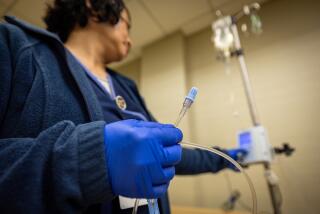Avandia: When does a drug’s harm outweigh its benefit?
It’s scary enough that a widely prescribed diabetes drug, Avandia, was shown in new studies this week to pose a substantially greater risk of heart attacks for users.
But what should really get consumers freaked is that healthcare experts and federal regulators say this isn’t really surprising. When it comes to drug safety, they say, you can’t make an omelet without breaking a few eggs.
“You can improve safety by keeping drugs off the market for more testing,” said William Comanor, director of UCLA’s Research Program in Pharmaceutical Economics and Policy. “But then you’re not helping people who might benefit from that drug.
“It’s a balance,” he said. “You don’t want to bring out a drug too soon, but you don’t want to be too late. Where the middle ground is, I don’t think anyone can say for sure.”
As someone with Type 1 diabetes (who hasn’t taken Avandia), I find that deeply troublesome — as should anyone who relies on prescription drugs to either make them or keep them well. By the time a medicine reaches consumers, it would be nice to think we know everything it can do to you, good and bad.
But that’s not the case. Nor is there seemingly any great urgency to pull a drug off the market when safety issues arise. That process can take years.
“It’s always a balancing act for us,” said Karen Riley, a spokeswoman for the Food and Drug Administration. “Products get approval because we see that the benefits outweigh the risks. Then we try to adjust as we go along.”
Avandia is a good case in point. The drug, manufactured by Britain’s GlaxoSmithKline, is intended to help people with Type 2 diabetes lower their blood sugar levels. Type 2 is the fast-growing form of diabetes frequently associated with obesity. Type 1 is usually genetic.
Backed by a multimillion-dollar ad campaign, sales of Avandia topped $1 billion last year, with more than 2 million prescriptions filled.
But for years questions have been raised about the drug’s safety. A 2007 study found that Avandia can increase the risk of heart attack by as much as 43%. Two new studies this week support that finding and suggest that Avandia may be responsible for thousands of heart attacks, strokes or heart problems.
Three years ago, a panel of independent experts acknowledged that Avandia could increase a user’s heart attack risk but recommended that it remain on the market. An FDA oversight board voted 8 to 7 to accept that advice.
A new panel of experts will convene this month to once again advise regulators on what to do about Avandia.
Glaxo has consistently maintained that the drug is safe. The company said in a statement that Avandia “does not increase the overall risk of heart attack, stroke or death.”
But Sidney Wolfe, director of health research for the advocacy group Public Citizen, said he and other watchdogs have been warning regulators of Avandia’s dangers for years “based on a crescendo of reports of the drug causing heart attacks.”
He said one key problem with the FDA’s drug-approval process is that a much greater emphasis is placed on the effectiveness of a medication than on its safety. “Only the grossest, most commonly occurring things will show up in clinical trials designed to determine efficacy,” Wolfe said.
Another problem, he said, is that the FDA relies on industry funding in the form of “user fees” for about 70% of its drug-testing budget.
“There’s something very wrong when the industry can essentially view the FDA as a client,” Wolfe said.
Joshua Sharfstein, the FDA’s principal deputy commissioner, responded that “the most important thing is that the agency have the funding and the resources to do its job well.” He said there’s no conflict in the agency receiving much of that funding from the industry it oversees.
Sharfstein added, though: “If Congress would decide to adequately fund the agency, that would be great.”
I understand the fine line that regulators have to walk in trying to keep the public safe from potentially dangerous drugs while simultaneously trying to get effective remedies to people who need them. There’s a necessary element of risk built into the system.
The pain reliever Vioxx was pulled from the market by its manufacturer, Merck & Co., in 2004 after studies showed a risk of heart attacks and strokes. But the FDA had known of such problems since at least 2000.
What drugs like Vioxx and Avandia highlight is that when dangerous side effects become known — or at the very least strongly suspected — it’s important for regulators to step in quickly with a second look.
That means an immediate moratorium on sales as soon as a credible study raises questions about safety. It means additional research by the manufacturer to address the new concerns.
If a drug becomes unavailable for a matter of months or even years, so be it. In most cases, there will be other drugs to address people’s medical needs. Avandia isn’t the only drug that helps people with Type 2 diabetes lower their glucose levels. Vioxx wasn’t the only pain reliever.
“Suppose a drug saves five people and kills one person,” said UCLA’s Comanor. “Do you keep it on the market? I don’t think anyone really knows the answer to that question.”
I know this: If that one person killed is my loved one — or yours — the answer is readily apparent.
It’s not that eggs don’t get broken when you cook. The real issue here is how frequently you pause to clean up.
David Lazarus’ column runs Tuesdays and Fridays. He also can be seen daily at KTLA-TV Channel 5. Send your tips or feedback to david.lazarus@latimes.com







